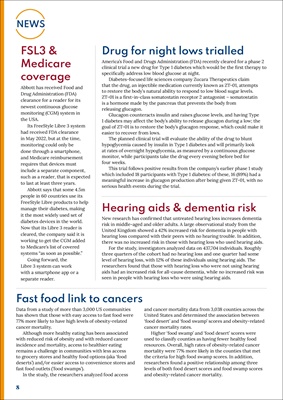
8
NEWS
FSL3 &
Medicare
coverage
Abbott has received Food and
Drug Administration (FDA)
clearance for a reader for its
newest continuous glucose
monitoring (CGM) system in
the USA.
Its FreeStyle Libre 3 system
had received FDA clearance
in May 2022, but at the time,
monitoring could only be
done through a smartphone,
and Medicare reimbursement
requires that devices must
include a separate component,
such as a reader, that is expected
to last at least three years.
Abbott says that some 4.5m
people in 60 countries use its
FreeStyle Libre products to help
manage their diabetes, making
it the most widely used set of
diabetes devices in the world.
Now that its Libre 3 reader is
cleared, the company said it is
working to get the CGM added
to Medicare's list of covered
systems "as soon as possible."
Going forward, the
Libre 3 system can work
with a smartphone app or a
separate reader.
Drug for night lows trialled
America's Food and Drugs Administration (FDA) recently cleared for a phase 2
clinical trial a new drug for Type 1 diabetes which would be the first therapy to
specifically address low blood glucose at night.
Diabetes-focused life sciences company Zucara Therapeutics claim
that the drug, an injectible medication currently known as ZT-01, attempts
to restore the body's natural ability to respond to low blood sugar levels.
ZT-01 is a first-in-class somatostatin receptor 2 antagonist - somatostatin
is a hormone made by the pancreas that prevents the body from
releasing glucagon.
Glucagon counteracts insulin and raises glucose levels, and having Type
1 diabetes may affect the body's ability to release glucagon during a low; the
goal of ZT-01 is to restore the body's glucagon response, which could make it
easier to recover from lows.
The planned clinical trial will evaluate the ability of the drug to blunt
hypoglycemia caused by insulin in Type 1 diabetes and will primarily look
at rates of overnight hypoglycemia, as measured by a continuous glucose
monitor, while participants take the drug every evening before bed for
four weeks.
This trial follows positive results from the company's earlier phase 1 study
which included 18 participants with Type 1 diabetes: of these, 16 (89%) had a
meaningful increase in glucagon production after being given ZT-01, with no
serious health events during the trial.
Hearing aids & dementia risk
New research has confirmed that untreated hearing loss increases dementia
risk in middle-aged and older adults. A large observational study from the
United Kingdom showed a 42% increased risk for dementia in people with
hearing loss compared with their peers with no hearing trouble. In addition,
there was no increased risk in those with hearing loss who used hearing aids.
For the study, investigators analyzed data on 437,704 individuals. Roughly
three quarters of the cohort had no hearing loss and one quarter had some
level of hearing loss, with 12% of these individuals using hearing aids. The
researchers found that those with hearing loss who were not using hearing
aids had an increased risk for all-cause dementia, while no increased risk was
seen in people with hearing loss who were using hearing aids.
Fast food link to cancers
Data from a study of more than 3,000 US communities
has shown that those with easy access to fast food were
77% more likely to have high levels of obesity-related
cancer mortality.
Although more healthy eating has been associated
with reduced risk of obesity and with reduced cancer
incidence and mortality, access to healthier eating
remains a challenge in communities with less access
to grocery stores and healthy food options (aka 'food
deserts') and/or easier access to convenience stores and
fast food outlets ('food swamps').
In the study, the researchers analyzed food access
and cancer mortality data from 3,038 counties across the
United States and determined the association between
'food desert' and 'food swamp' scores and obesity-related
cancer mortality rates.
Higher 'food swamp' and 'food desert' scores were
used to classify counties as having fewer healthy food
resources. Overall, high rates of obesity-related cancer
mortality were 77% more likely in the counties that met
the criteria for high food swamp scores. In addition,
researchers found a positive relationship among three
levels of both food desert scores and food swamp scores
and obesity-related cancer mortality.